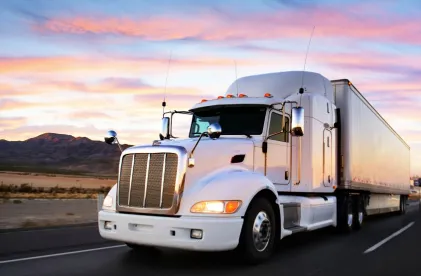The US Environmental Protection Agency (US EPA) and the California Air Resources Board (CARB) are proceeding with development of proposed rules for on-road heavy-duty vehicle and engine regulation. As previously covered in our blog, US EPA and DOT already issued a final rule in early April rolling back greenhouse gas emission (GHG) standards in the context of light-duty vehicles. In anticipation of forthcoming regulation, we are following regulatory developments proposed for the heavy-duty vehicle and engine sector. Anticipated requirements include more stringent NOx standards, changes to test procedures, requirements for zero-emission vehicles in California, and consideration of advanced technologies.
Federal Clean Trucks Initiative
US EPA issued an Advanced Notice of Proposed Rulemaking (ANPR) in January 2020 requesting pre-proposal comments on its Cleaner Trucks Initiative for highway heavy-duty vehicles and engines. Next steps identified at the end of the notice included publishing a Notice of Proposed Rulemaking (NPRM) in 2020 after reviewing comments. In the Fall 2019 Unified Agenda, the agency listed the projected date for the NPRM as June 2020 although there could be delays in publication as a result of the COVID-19 pandemic.
In the notice, US EPA explained that the impetus behind preparing revised standards for NOx emissions sources from the significant contribution of heavy-duty vehicles and engines to NOx emissions and the need to reduce impacts to assist with compliance with National Ambient Air Quality Standards (NAAQS). The agency also acknowledged the potential for collaboration with CARB in preparing a 50-state standard. There are two pathways to regulation in the heavy-duty context – as an engine or chassis-certification of the entire vehicle. US EPA qualified that the ANPR applies to certification of engines and “[w]e do not intend to propose changes to the standards or test procedures for chassis-certified heavy-duty vehicles.” However, the agency did not provide a value for the engine emission standard but did provide the timing would be model year (MY) 2027.
Since the proposed rule will take into consideration available technology, US EPA outlined its understanding of technologies available for diesel and gasoline engines from 2024 to 2030 and requested public input. For example, for diesel engines, US EPA is considering passive and active thermal management technologies that can be used to “better achieve and maintain adequate catalyst temperatures” and strategies to improve catalyst performance across operating conditions. Other technologies under consideration include variable valve actuation, dual-SCR catalyst systems, aftertreatment durability, fuel quality, and closed crankcases.
The agency also indicated it may prepare updates to the duty-cycle program used for testing heavy-duty engines, such as changes to the weighting factors for the Federal Test Procedure (FTP) cycle and a potential new low-load test cycle and associated emission standard. A low load cycle may come into play because diesel engines using SCR-based emission controls spend more time in low load and idle than existing test procedures anticipated. Other topics covered in the notice included modifications to regulatory useful life, long-term in-use emissions performance, warranty period and coverage, tamper-resistant electronic controls, improvement of engine-rebuilding practices, and streamlining of compliance certification.
California: Heavy-Duty Low NOx Omnibus Rulemaking
There is no sign CARB is slowing down in its regulatory efforts for heavy-duty engines and vehicles despite pressure from industry and lawmakers. For example, thirty one state lawmakers requested CARB place current and proposed rulemakings for freight transportation and harbor craft on hold until January 2021. However, to date, CARB has not agreed to provide such a pause in rulemaking efforts. One of those proposed rulemakings is the anticipated heavy-duty omnibus low NOx regulation. This regulation is expected to reduce exhaust emission standards for heavy-duty diesel engines to 0.05 g/bhp-hr for MY 2024-2026 and 0.02 g/bhp-hr for MY 2027 and later engines. For comparison, the current standard is 0.2 g/bhp-hr, and this represents a steep reduction. California previously implemented an optional low NOx standards program for heavy-duty engines in 2014 with standards including 0.10 g/bhp-hr, .05 g/bhp-hr, and 0.02 g/bhp-hr.
In its comment to US EPA’s ANPR in January 2020, CARB provided insight on the terms of its forthcoming heavy-duty omnibus regulation, the timing, and the agency’s support for coordination with the federal government. Prior to the pandemic, CARB anticipated that the proposal could be released as early as April 2020 for public review and comment, and the rule would be effective for MY 2024. Specifically, Richard Corey, an Executive Officer with CARB, explained that the rule will likely include the following elements:
-
“Significantly more stringent exhaust emission standards and test procedures for 2024 and subsequent model year engines, including 2027 model year standards approximately 90 percent lower than today’s standards;
-
A new low-load certification test cycle that demonstrates emission control during sustained low-load engine operation, which constitutes a large fraction of how trucks actually operate in urban areas;
-
Durability demonstrations at certification that correlate with in-use emissions performance experience;
-
Revamping the current heavy-duty in-use testing (HDIUT) program to require better emission control and cover all modes of in-use operation;
-
Increased regulatory useful life to more accurately reflect how long trucks are used today (for example, to 800,000 miles for the heaviest trucks); and
-
Longer emission warranty coverage (for example, to 600,000 miles for the heaviest trucks) to help ensure that emission control systems are well-designed and built properly and make it more likely that emissions-related repairs are completed promptly.”
California: Advanced Clean Trucks
CARB has already issued additional revisions to its proposed rule for the Advanced Clean Trucks Regulation on April 28, 2020 and the revisions are expected to be approved by CARB in late June. Comments are due to the agency by May 28, 2020. The regulation will affect on-road medium and heavy-duty trucks, and the agency’s intention is to encourage manufacturers to move toward “widespread adoption of zero-emission vehicles.” For some classes of vehicles, this could include up to 50% ZEV sales by 2030. As part of the published, proposed revisions, CARB increased the number of zero-emission vehicles (ZEVs) required to be sold across all vehicles groups, included pickup trucks beginning in MY 2024 instead of MY 2027, provided changes to streamline reporting, and clarified definitions of vehicles as on-road. The result would be to require approximately 300,000 ZEV in California by 2035 instead of 150,000 in an earlier draft.
The rule, the first of its kind, will require manufacturers who certify on-road vehicles over 8,500 gross vehicle weight rating (GVWR) to manufacture ZEV trucks as part of their fleet. Vehicles are further defined into classes based on weight and type – for example, Classes 4-8 include vehicles weighing greater than 14,001 pounds. CARB will monitor the development and inclusion of ZEV through the use of a system of credits and deficits where manufacturers can achieve compliance with the requirements when the total credits retired offset total deficits. For example, section 1963.1 in the proposed revisions provides a chart with deficit calculation per model year and class of vehicle. Manufacturers then can generate ZEV credits for the sale of ZEV produced and delivered for sale in California under proposed section 1963.2.
Significantly, one of the proposed revisions includes a more stringent enforcement mechanism in section 1963.5. If approved by CARB and incorporated into the proposed rule, the revision provides that manufacturers that fail to make up deficits and retire appropriate credits as outlined in the rule “shall be subject to Health and Safety Code section 43211 civil penalty applicable to a manufacturer that sells a new on-road vehicle that does not meet the applicable emission standards adopted by the state board.” Agency staff explained in the notice this addition is necessary to provide clarity and consistency in measuring noncompliance.
We will continue to follow and update readers on the development of this issue.




 />i
/>i

